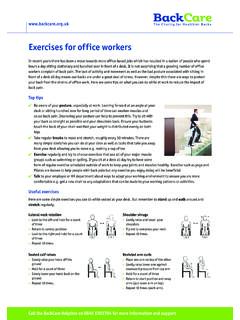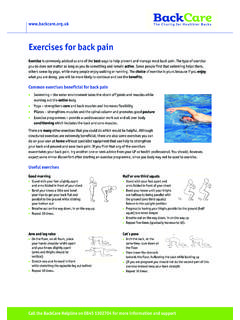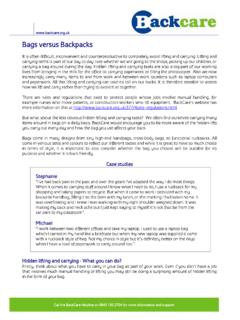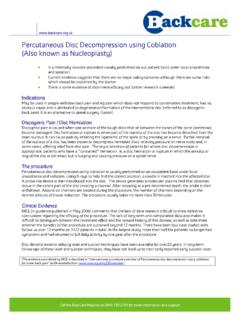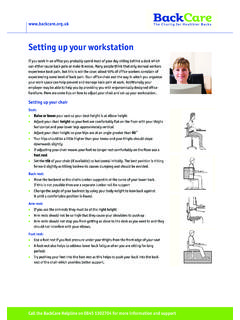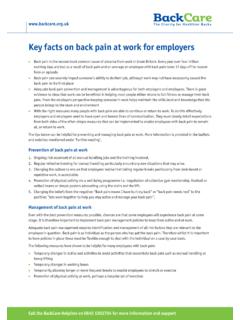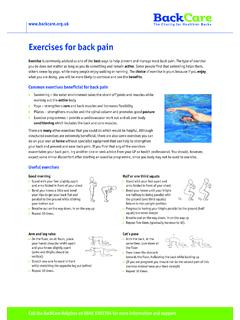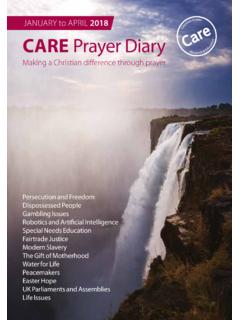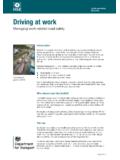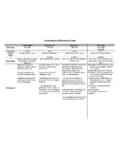Transcription of Back Pain Booklet - BackCare Home Page - BackCare
1 Standards of care for people with back pain Contents The background 1. About these Standards 3. The Standards of care : Standards to improve access to information, support and knowledge 5. Standards to improve access to the right services that enable early assessment and management 7. Standards to improve access to ongoing and responsive treatment and support 10. Glossary 13. Appendix 1: Evidence-based interventions 14. Appendix 2: Developing the Standards 14. Acknowledgements 14. Bibliography 17. ARMA is the umbrella organisation for the UK musculoskeletal community. ARMA is a registered charity No 1108851. Our member organisations are: Arthritis care Manipulation Association of Chartered Physiotherapists (UK). Arthritis Research Campaign Marfan Association (UK).
2 BackCare National Ankylosing Spondylitis Society British Chiropractic Association National Association for the Relief of Paget's Disease British Coalition of Heritable Disorders of Connective Tissue National Association of Rheumatology Occupational British Health Professionals in Rheumatology Therapists (NAROT). British Institute of Musculoskeletal Medicine National Osteoporosis Society British Orthopaedic Association National Rheumatoid Arthritis Society British Scoliosis Society Podiatry Rheumatic care Association British Sj gren's Syndrome Association Primary care Rheumatology Society British Society for Paediatric and Adolescent Rheumatology Psoriatic Arthropathy Alliance British Society for Rheumatology Raynaud's and Scleroderma Association British Society of Rehabilitation Medicine Rheumatoid Arthritis Surgical Society Chartered Society of Physiotherapy Royal College of Nursing Rheumatology Nursing Children's Chronic Arthritis Association Policy and Practice Group CHOICES for Families of Children with Arthritis Scleroderma Society Early
3 Rheumatoid Arthritis Network Society for back pain Research Lupus UK. Photographs on front cover reproduced by kind permission of BackCare Nov 2004 Arthritis and Musculoskeletal Alliance Any part of this publication may be freely reproduced for non-commercial purposes and with the appropriate acknowledgement. The contents of this document and further resources including contact details for our member organisations, further information about our work and this project, including additional examples of good practice and resources to support implementation are available on the ARMA website at The Standards of care project has been managed by ARMA. The project has been funded from a range of sources, including unrestricted educational grants from a number of pharmaceutical companies.
4 A wide range of individuals and organisations have given time, expertise and other support in kind. For details of contributors, please see Acknowledgements on page 14. The background back pain : the size of the problem back pain is a major health problem, affecting approximately million people in the UK . over one-third of the adult population. Over the course of a year, around million people experience back pain for the first time, and for million people their pain lasts throughout the whole year. It affects men and women equally, and more people experience back pain as they grow older.[1]. What is the impact of back pain ? Persistent back pain (ie pain which has lasted for more than three months or has been present on more than half the days of the previous year), in particular, has a serious impact on people's lives.
5 It frequently reduces people's quality of life and adversely affects their family and social relationships.[2] back pain can also impact on a person's ability to work, and compromise their earning capacity. Moreover, the longer someone is absent from work with back pain , the poorer their chances are of returning.[3]. The direct healthcare costs of back pain are huge, including 141 million each year for GP. consultations and 512 million for hospital care (inpatient, outpatient and emergency). Overall, back pain costs the NHS and community care services more than 1 billion each year and with 565 million also spent on private services, the direct annual healthcare costs are over billion.[4]. Unsurprisingly, back pain has a massive economic impact. It is the second commonest cause of long-term sickness absence for much of the UK[5], and the commonest for people in manual occupations.
6 [6] Up to 180 million working days were lost in 1997/8 due to back pain , including 119 million that were lost due to registered disability caused by back problems.[7] Reports have estimated that the total cost of back pain corresponds to between 1% and 2% of gross national product (GNP).[8]. Types of back pain There are many different causes of back pain but in most cases the cause is uncertain and the condition is referred to as 'simple' or 'mechanical' back pain . In the remaining cases, it is important to make a specific diagnosis as the underlying pathology may be serious, even life- threatening, or require a specific type of treatment. Examples of serious spinal pathology include tumour and infection, fracture due to trauma or osteoporosis, inflammatory disease as in ankylosing spondylitis, structural deformity such as scoliosis and extensive neurological complications.
7 Between the simple' and serious cases are individuals with nerve root pain (also known as sciatica), which is commonly due to a disc prolapse ( slipped disc'). The majority of people with back pain will not require anything more than conservative management, including advice, pain control and exercises. These Standards of care focus on simple' or mechanical' back pain . Why we need Standards of care The care of people with back pain involves many different professions and disciplines, and until now there has been no standardised approach. Despite the publication of Clinical Standards 1. Advisory Group (CSAG) Guidelines in 1994, people's experiences and the quality of the care which they receive vary enormously depending on the approach and configuration of services where they live.
8 Current provision is often poorly co-ordinated and may not fully incorporate evidence-based practice. Worryingly, many people continue to believe that bed rest is the best way to manage an episode of back pain . Indeed, some healthcare providers continue to promulgate the message. Given the huge costs of back pain to the NHS and to national productivity, it is a major drawback that there is no National Service Framework either for back pain or for other musculoskeletal conditions. This lack of focus is reflected in the fact that back pain does not feature in the Quality and Outcomes Framework of the current General Medical Services (GMS). contract in England. Yet there is good evidence for the effectiveness of many approaches and treatments. Moreover, despite the lack of priority and resources attached to back pain services, health services in some parts of the UK have identified innovative ways of improving the care that they provide.
9 These Standards aim to bring together existing evidence and good practice to create a framework for services which really meet the needs of the many people with back pain . Implementation of these Standards should: improve quality of life for the millions of people who are affected by back pain each year identify for people with back pain the care and treatment which they can expect enable the NHS to make more effective use of resources by helping to prevent avoidable disability and by reducing the number of return GP consultations and hospital appointments due to back pain promote consistent advice and treatment reduce levels of disability due to back pain improve productivity and reduce the benefits bill, by supporting people to stay active and remain in work.
10 1 Maniadakis A, Gray A (2000). 2 pain in Europe (2003). 3 Clinical Standards Advisory Group (1994). 4 Maniadakis A, Gray A (2000). 5 Department for Work and Pensions (2002). 6 Chartered Institute of Personnel and Development (2004). 7 Department of Health (2000). 8 Norlund AI, Waddell G (2000). 2. About these Standards ARMA's Standards of care for people with back pain are intended to support people of all ages with back pain to lead independent lives and reach their full health potential through: access to information, support and knowledge that optimise musculoskeletal health for everyone and enable self-management access to the right services that enable early diagnosis and treatment access to ongoing and responsive treatment and support. The Standards define what services are appropriate under these three themes and suggest ways of providing them effectively, and in a measurable way, in the form of key interventions.
